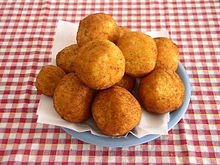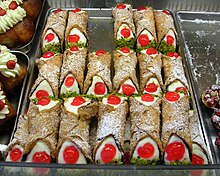Sicilian cuisine
The Sicilian cuisine is a versatile regional cuisine of Italy . It is characterized by the abundant income from agriculture and fishing and the influences of foreign cultures in the history of Sicily . Simply put, the kitchen can be described as pasta, pesce e pasticceria , i.e. pasta, fish and desserts. Pasta dishes are mainly served with vegetables, fish is used much more often than meat and the Sicilian desserts are among the richest and most colorful in the world. The diversity of Sicilian cuisine lies in the fact that each recipe in the individual provinces is enriched and refined with very different ingredients .
Basic ingredients
The basic components of Sicilian cuisine are primarily products from their own farming and fishing.
The main crops are lemons , oranges , tomatoes and olives , which are used for both pickling and the production of olive oil . Other products include durum wheat for making pasta , peppers , artichokes , a variety of culinary herbs and, last but not least, aubergines , which are found in many recipes in Sicily. Almonds , pine nuts and pistachios are used to refine dishes as well as for many desserts and pastries.
In Sicilian cuisine, wild plants and herbs are often used, which are either eaten raw, cooked or pickled. These include wild fennel , wild asparagus , borage (cucumber herb), wild chard , thistle-artichoke , capers and chicory ( chicory ).
The most common types of fish used in cooking include tuna , swordfish , anchovies , sardines and numerous crustaceans . Fish is mostly freshly prepared, but can also be preserved in olive oil, smoked or dried. Small fish are often fried and served as an accompaniment to other dishes. Meat dishes mainly consist of lamb , wild rabbit or pork .
In addition to the income from agriculture and fishing, cheese is produced in many regions of Sicily. Ricotta is mainly used in pastry shops for making creamy desserts and fillings, but also for filling cassatelle (Sicilian ravioli) or as a sauce for pasta dishes. Other typical cheese specialties are the Ragusano , the pear-shaped Caciocavallo and the Pecorino siciliano . The young, still soft pecorino, also called Primo Sale, is often used in place of the mozzarella that is otherwise common in Italy, the ripe and spicier Pecorino in place of the grated Parmesan.
Influence of foreign cultures
The eventful history of Sicily is reflected in today's cuisine. So with the Greeks, olives, salty ricotta, honey and wine came to the island. Already in ancient Syracuse in the 5th century BC. Founded a cooking school and wrote a cookbook : Il cuoco siciliano , the Sicilian cook.
The Romans began to intensively cultivate durum wheat in the interior of the island and for the first time produced a kind of ice cream by sweetening the ice cream of Etna with honey and coloring it with fruit juice. From them one learned, among other things, to prepare bratwurst and Maccu . Maccu is a puree made from broad beans, onions and garlic that is eaten with bread or pasta. For centuries it was the main food of the farmers who took the dish in clay amphorae to the fields.
The Arabs introduced rice , citrus fruits , novel spices, sugar , almonds and marzipan . The preparation of stockfish and roulades was taken over from the Normans . In addition to new types of vegetables such as tomatoes, aubergines and peppers, the Spaniards also brought with them the knowledge of making chocolate . The proximity to the African continent is evident in the area between San Vito lo Capo and Trapani , where different types of couscous are cooked.
From today's perspective, the Arabs have had the most lasting influence on Sicilian cuisine. The introduction of rice preparation began arancini , small rice balls, and with the Arab sweet tooth manufacturing began traditional desserts like cassata or Frutta martorana .
Selection of typical dishes
Typical starters for Sicily are arancini , fried rice balls, which are filled or shaped differently depending on the region. Another specialty is caponata , a sweet and sour dish made from peppers, aubergines, capers and onions. Popular snacks are sfincione , a pizza made from sweet bread dough that is topped in different ways, or scàccia , filled dumplings.
In addition to spaghetti, macaroni are preferred for pasta dishes . Typical pasta specialties include pasta alla Norma based on a recipe from Catania , pasta con le sarde with sardines and pasta con le melanzane with aubergines.
Meat dishes are mainly prepared in the mountain regions in the interior of the island. Specialties are the Farsu magru , a roll roast, and the Involtini alla siciliana , richly filled roulades.
Fish dishes are preferred along the coast. Swordfish from the Messina area , tuna from the waters off Trapani or sardines are usually prepared alla griglia, i.e. only grilled and eaten with salad and fresh bread. Couscous is served exclusively with boiled fish, cauliflower or, on Maundy Thursday, with pork and not, as is common in North Africa, with mutton or chicken. A particular specialty are stuffed fish such as the sardine a beccafico .
Since the Sicilian dolci, i.e. the sweet desserts, are very rich and filling, the meals are often rounded off with fruit, fresh fruit salad or cheese instead.
Selection of typical desserts
Pastries and confectionery have played a major role in Sicilian cuisine for centuries. They were previously made in monasteries and primarily for clergy and nobles. Today they are offered in large quantities on both church holidays and family celebrations. So there are z. B. traditionally the cassata , a layer cake made of biscuit dough, ricotta and candied fruit, and at Christmas the pignolata . For the feast of Saint Lucia on December 13th, the dessert Cuccìa is prepared.
The numerous cafes and ice cream parlors offer a variety of ice creams and granita . The Sicilian pastry shops are worth seeing. In the shop windows and ricotta-filled pastry rolls, which are piled up next to mountains of almond, pistachio and pine pastry cannoli and deceptively real looking marzipan fruits Frutti della Martorana .
Selection of typical drinks
Wine is usually drunk with main meals. The soils and the climate are ideal for viticulture in Sicily , which has been practiced since the immigration of the Greeks. Today all the provinces of the island produce wine and with the introduction of modern pressing methods, Sicily's DOC wines are establishing themselves on the European wine market.
The red wines have an alcohol content of 12.5 to 14 percent and are often drunk in the evening with fried or grilled food. The famous red wines include the Cerasuolo di Vittoria , the Nero d'Avola and the Perricone . The dry white and rosé wines with an alcohol content of 11.5 to 12 percent go well with fish, poultry and pasta dishes.
Various dessert wines are also produced, such as the world-famous Marsala , Malvasia delle Lipari or Vino di mandorle , an almond wine.
Other typical Sicilian drinks are limoncello , a lemon liqueur, and Amaro Siciliano , a herbal bitters that is often drunk as a digestif after meals .
literature
- Chris Meier et al. a .: Sicily. Culinary travel sketches. Hädecke Verlag, Weil der Stadt 1997, ISBN 3-7750-0307-X .
- Cettina Vicenzino: Mamma Maria! Family recipes from Sicily. Christian Verlag, Munich 2009, ISBN 978-3-88472-948-9
- Cettina Vicenzino: SICILY in my kitchen. Dorling Kindersley Verlag, Munich 2018, ISBN 978-3-8310-3727-8








